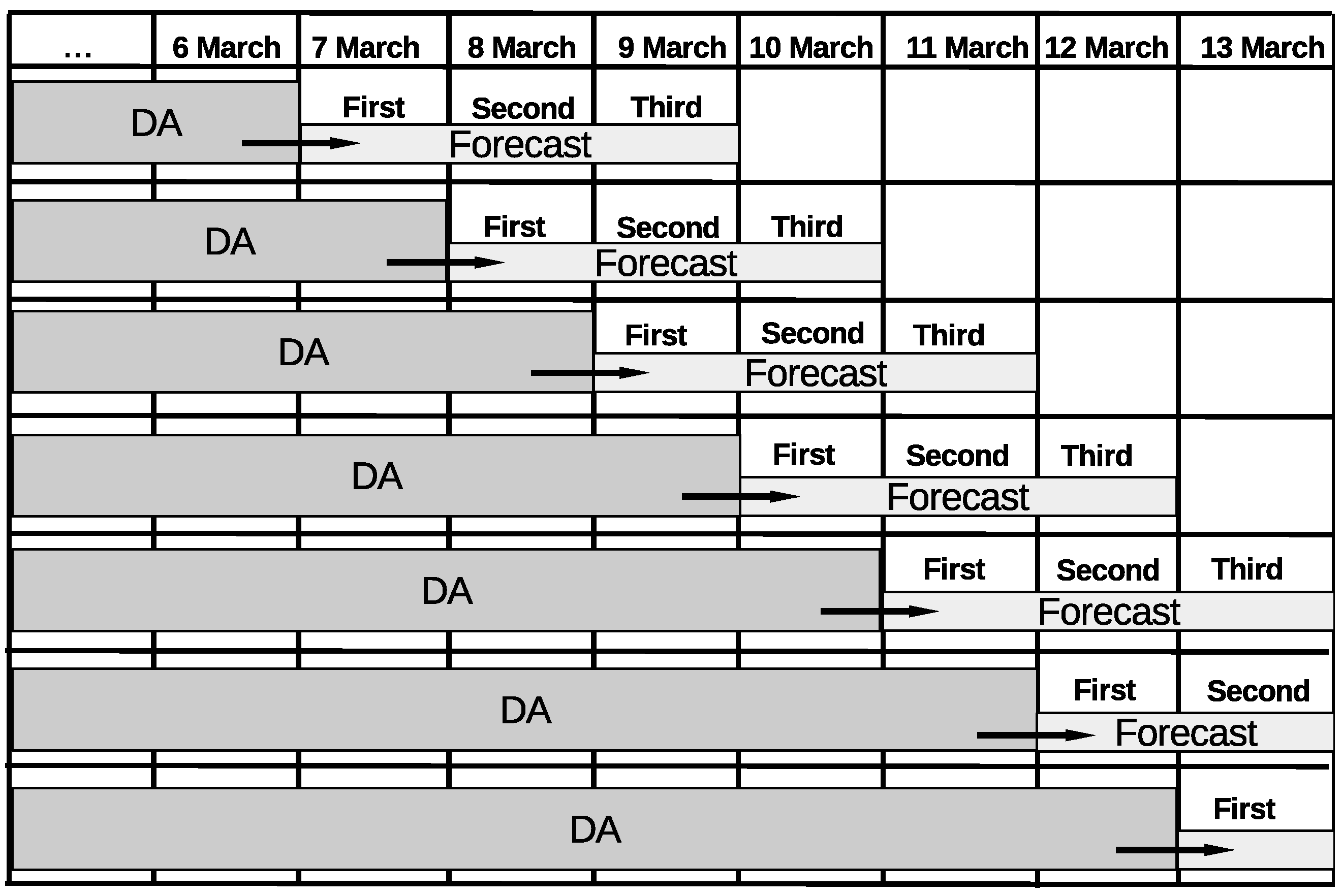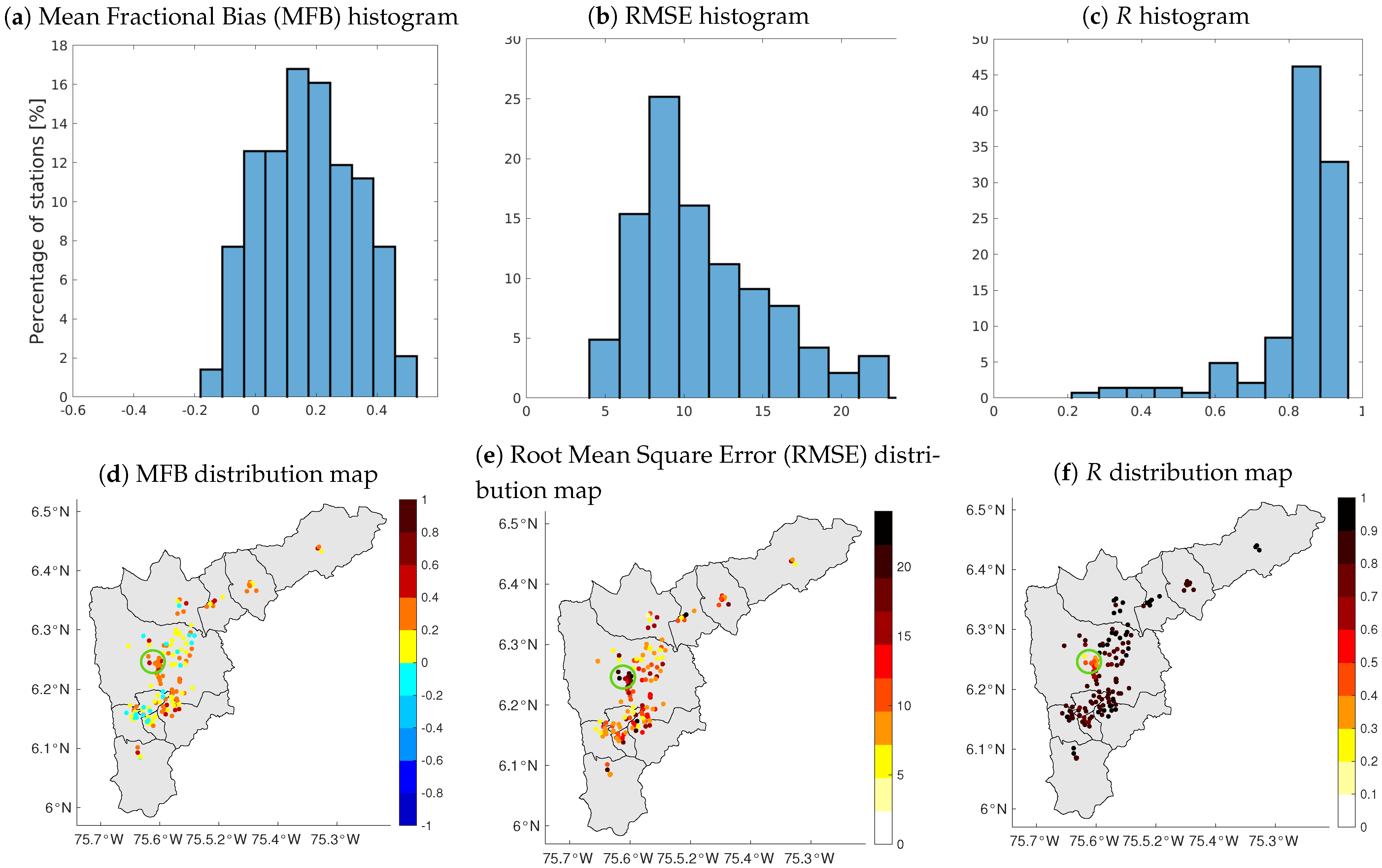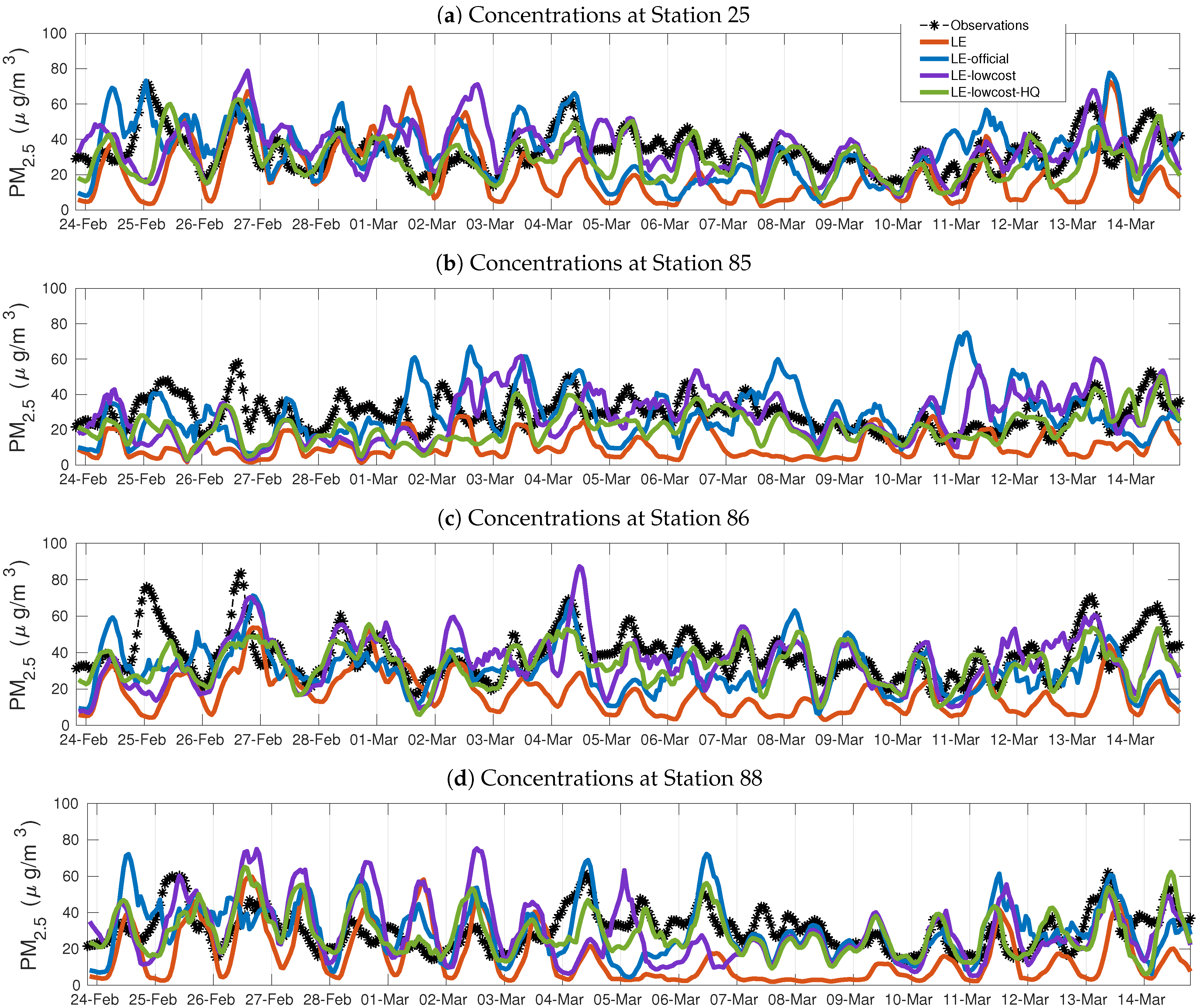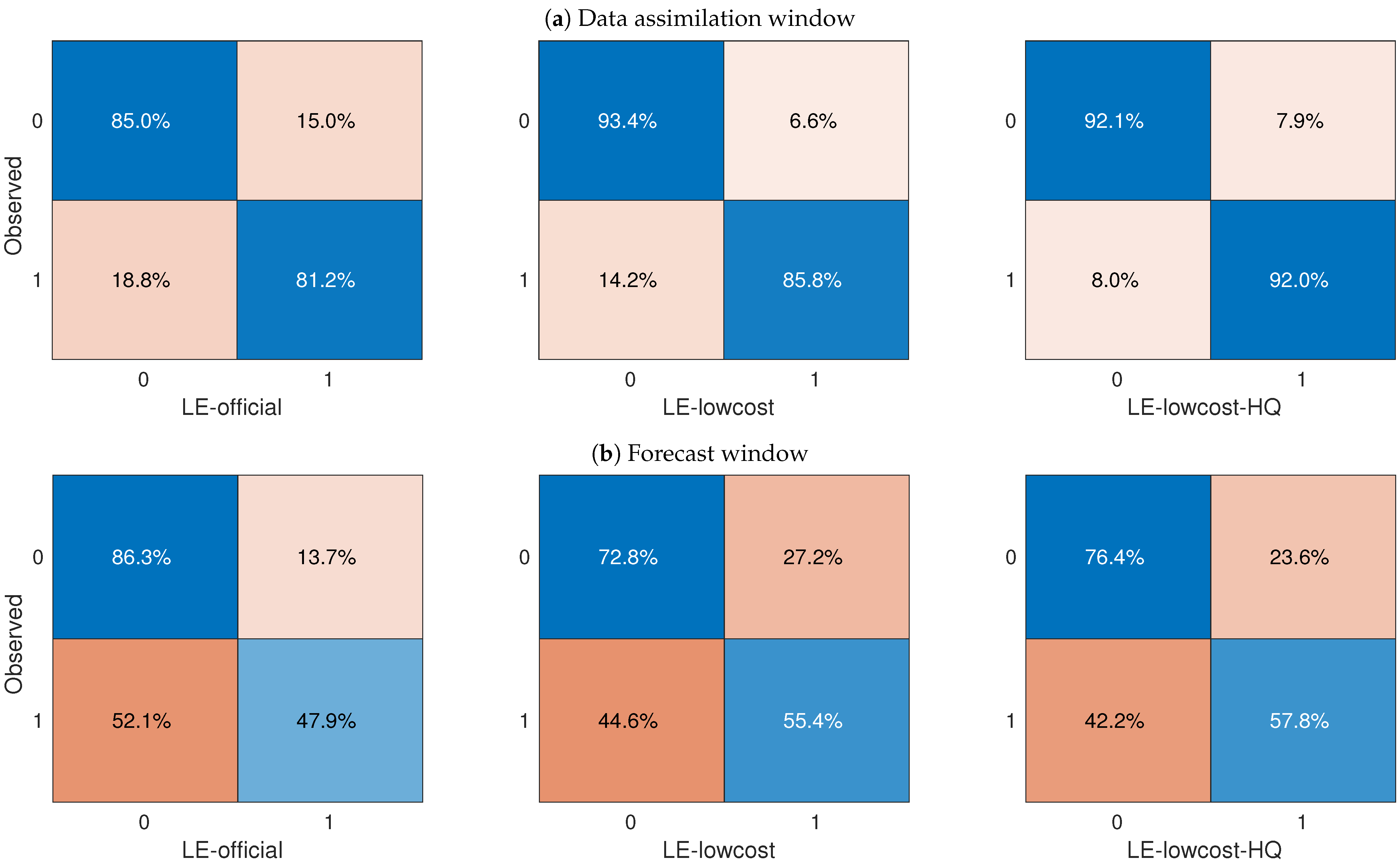Urban Air Quality Modeling Using Low-Cost Sensor Network and Data Assimilation in the Aburrá Valley, Colombia
Abstract
1. Introduction
2. Materials and Methods
2.1. Hyper-Dense Low-Cost Sensor Network
2.2. Particulate Matter Modelling
2.2.1. LOTOS-EUROS Model
2.2.2. Local Emissions Inventory
2.3. Ensemble Kalman Filter
- a LOTOS-EUROS model simulation without data assimilation (henceforth LE);
- a simulation with assimilation of data (observations) from the 14 stations of the official network (henceforth LE-official);
- a simulation with assimilation of the data from the entire low-cost network (henceforth LE-lowcost)
- a simulation with assimilation only of high-quality data from the low-cost network (henceforth LE-lowcost-HQ).
2.4. Forecast Experiments
3. Results
3.1. Evaluation with Low-Cost Sensor Network
3.2. Evaluation of Data Assimilation Runs
3.3. Evaluation of Forecasts
4. Discussion
5. Conclusions
Author Contributions
Funding
Acknowledgments
Conflicts of Interest
References
- Liu, H.Y.; Bartonova, A.; Schindler, M.; Sharma, M.; Behera, S.N.; Katiyar, K.; Dikshit, O. Respiratory Disease in Relation to Outdoor Air Pollution in Kanpur, India. Arch. Environ. Occup. Health 2013, 68, 204–217. [Google Scholar] [CrossRef] [PubMed]
- Liu, H.Y.; Dunea, D.; Iordache, S.; Pohoata, A. A Review of Airborne Particulate Matter Effects on Young Children’s Respiratory Symptoms and Diseases. Atmosphere 2018, 9, 150. [Google Scholar] [CrossRef]
- Su, X.; Sutarlie, L.; Loh, X.J. Sensors and Analytical Technologies for Air Quality: Particulate Matters and Bioaerosols. Chem. Asian J. 2020. [Google Scholar] [CrossRef] [PubMed]
- Le, T.C.; Shukla, K.K.; Chen, Y.T.; Chang, S.C.; Lin, T.Y.; Li, Z.; Pui, D.Y.; Tsai, C.J. On the concentration differences between PM2.5 FEM monitors and FRM samplers. Atmos. Environ. 2020, 222, 117138. [Google Scholar] [CrossRef]
- Masic, A.; Bibic, D.; Pikula, B.; Blazevic, A.; Huremovic, J.; Zero, S. Evaluation of optical particulate matter sensors under realistic conditions of strong and mild urban pollution. Atmos. Meas. Tech. 2020, 13, 6427–6443. [Google Scholar] [CrossRef]
- Tagle, M.; Rojas, F.; Reyes, F.; Vásquez, Y.; Hallgren, F.; Lindén, J.; Kolev, D.; Watne, Å.K.; Oyola, P. Field performance of a low-cost sensor in the monitoring of particulate matter in Santiago, Chile. Environ. Monit. Assess. 2020, 192. [Google Scholar] [CrossRef]
- Bai, L.; Huang, L.; Wang, Z.; Ying, Q.; Zheng, J.; Shi, X.; Hu, J. Long-term field evaluation of low-cost particulate matter sensors in Nanjing. Aerosol Air Qual. Res. 2020, 20, 242–253. [Google Scholar] [CrossRef]
- Kumar, A.; Gurjar, B.R. Low-Cost Sensors for Air Quality Monitoring in Developing Countries—A Critical View. Asian J. Water Environ. Pollut. 2019, 16, 65–70. [Google Scholar] [CrossRef]
- Ahangar, F.E.; Freedman, F.R.; Venkatram, A. Using low-cost air quality sensor networks to improve the spatial and temporal resolution of concentration maps. Int. J. Environ. Res. Public Health 2019, 16, 1252. [Google Scholar] [CrossRef]
- Kumar, P.; Morawska, L.; Martani, C.; Biskos, G.; Neophytou, M.; Di Sabatino, S.; Bell, M.; Norford, L.; Britter, R. The rise of low-cost sensing for managing air pollution in cities. Environ. Int. 2015, 75, 199–205. [Google Scholar] [CrossRef]
- Liu, H.Y.; Schneider, P.; Haugen, R.; Vogt, M. Performance assessment of a low-cost PM 2.5 sensor for a near four-month period in Oslo, Norway. Atmosphere 2019, 10, 41. [Google Scholar] [CrossRef]
- Schneider, P.; Castell, N.; Vogt, M.; Dauge, F.R.; Lahoz, W.A.; Bartonova, A. Mapping urban air quality in near real-time using observations from low-cost sensors and model information. Environ. Int. 2017, 106, 234–247. [Google Scholar] [CrossRef] [PubMed]
- Lahoz, W.A.; Schneider, P. Data assimilation: Making sense of Earth Observation. Front. Environ. Sci. 2014, 2, 1–28. [Google Scholar] [CrossRef]
- Popoola, O.A.; Carruthers, D.; Lad, C.; Bright, V.B.; Mead, M.I.; Stettler, M.E.; Saffell, J.R.; Jones, R.L. Use of networks of low cost air quality sensors to quantify air quality in urban settings. Atmos. Environ. 2018, 194, 58–70. [Google Scholar] [CrossRef]
- Evensen, G. The Ensemble Kalman Filter: Theoretical formulation and practical implementation. Ocean Dyn. 2003, 53, 343–367. [Google Scholar] [CrossRef]
- Hoyos, C.D.; Herrera-Mejía, L.; Roldán-Henao, N.; Isaza, A. Effects of fireworks on particulate matter concentration in a narrow valley: The case of the Medellín metropolitan area. Environ. Monit. Assess. 2019, 192, 6. [Google Scholar] [CrossRef]
- Manders, A.M.M.; Builtjes, P.J.H.; Curier, L.; Denier Van Der Gon, H.A.C.; Hendriks, C.; Jonkers, S.; Kranenburg, R.; Kuenen, J.J.P.; Segers, A.J.; Timmermans, R.M.A.; et al. Curriculum vitae of the LOTOS–EUROS (v2.0) chemistry transport model. Geosci. Model Dev. 2017, 10, 4145–4173. [Google Scholar] [CrossRef]
- Lopez-Restrepo, S.; Yarce, A.; Pinel, N.; Quintero, O.; Segers, A.; Heemink, A. Forecasting PM10 and PM2.5 in the Aburrá Valley (Medellín, Colombia) via EnKF based Data Assimilation. Atmos. Environ. 2020, 232, 117507. [Google Scholar] [CrossRef]
- Pournazeri, S.; Tan, S.; Schulte, N.; Jing, Q.; Venkatram, A. A computationally efficient model for estimating background concentrations of NOx, NO2, and O3. Environ. Model. Softw. 2014, 52, 19–37. [Google Scholar] [CrossRef]
- Chai, T.; Draxler, R.R. Root mean square error (RMSE) or mean absolute error (MAE): Arguments against avoiding RMSE in the literature. Geosci. Model Dev. 2014, 7, 1247–1250. [Google Scholar] [CrossRef]
- Boylan, J.W.; Russell, A.G. PM and light extinction model performance metrics, goals, and criteria for three-dimensional air quality models. Atmos. Environ. 2006, 40, 4946–4959. [Google Scholar] [CrossRef]
- Shaocai, Y.; Brian, E.; Robin, D.; Shao-Hang, C.; Schwartz, E.S. New unbiased symmetric metrics for evaluation of air quality models. Atmos. Sci. Lett. 2006, 7, 26–34. [Google Scholar] [CrossRef]
- Mues, A.; Kuenen, J.; Hendriks, C.; Manders, A.; Segers, A.; Scholz, Y.; Hueglin, C.; Builtjes, P.; Schaap, M. Sensitivity of air pollution simulations with LOTOS-EUROS to the temporal distribution of anthropogenic emissions. Atmos. Chem. Phys. 2014, 14, 939–955. [Google Scholar] [CrossRef]
- Sauter, F.; der Swaluw, E.V.; Manders-groot, A.; Kruit, R.W.; Segers, A.; Eskes, H. TNO Report TNO-060-UT-2012-01451; Technical Report; TNO: Utrecht, The Netherlands, 2012. [Google Scholar]
- Van Loon, M.; Builtjes, P.J.H.; Segers, A.J. Data assimilation of ozone in the atmospheric transport chemistry model LOTOS. Environ. Model. Softw. 2000, 15, 603–609. [Google Scholar] [CrossRef]
- UPB; AMVA. Inventario de Emisiones Atmosféricas del Valle de Aburrá–Actualización 2015; Technical Report; Universidad Pontificia Bolivariana–Grupo de Investigaciones Ambientales, Area Metropolitana del Valle de Aburra: Medellín, Colombia, 2017. [Google Scholar]
- Ossés de Eicker, M.; Zah, R.; Triviño, R.; Hurni, H. Spatial accuracy of a simplified disaggregation method for traffic emissions applied in seven mid-sized Chilean cities. Atmos. Environ. 2008, 42, 1491–1502. [Google Scholar] [CrossRef]
- Haklay, M.; Weber, P. OpenStreetMap: User-Generated Street Maps. IEEE Pervasive Comput. 2008, 7, 12–18. [Google Scholar] [CrossRef]
- Tuia, D.; Ossés de Eicker, M.; Zah, R.; Osses, M.; Zarate, E.; Clappier, A. Evaluation of a simplified top-down model for the spatial assessment of hot traffic emissions in mid-sized cities. Atmos. Environ. 2007, 41, 3658–3671. [Google Scholar] [CrossRef]
- Gómez, C.D.; González, C.M.; Osses, M.; Aristizábal, B.H. Spatial and temporal disaggregation of the on-road vehicle emission inventory in a medium-sized Andean city. Comparison of GIS-based top-down methodologies. Atmos. Environ. 2018, 179, 142–155. [Google Scholar] [CrossRef]
- Tippett, M.K.; Anderson, J.L.; Bishop, C.H.; Hamill, T.M.; Whitaker, J.S. Ensemble square root filters. Mon. Weather. Rev. 2003, 131, 1485–1490. [Google Scholar] [CrossRef]
- Jazwinski, A. Stochastic Processes and Filtering Theory; Number 64 in Mathematics in Science and Engineering; Acadamic Press: New York, NY, USA, 1970. [Google Scholar]
- Ott, E.; Hunt, B.R.; Szunyogh, I.; Zimin, A.V.; Kostelich, E.; Corazza, M.; Kalnay, E.; Patil, D.; Yorke, J.A. A local ensemble Kalman filter for atmospheric data assimilation. Tellus 2004, 56, 415–428. [Google Scholar] [CrossRef]
- Sakov, P.; Evensen, G.; Bertino, L. Asynchronous data assimilation with the EnKF. Tellus, Ser. Dyn. Meteorol. Oceanogr. 2010, 62, 24–29. [Google Scholar] [CrossRef]
- Henao, J.J.; Mejía, J.F.; Rendón, A.M.; Salazar, J.F. Sub-kilometer dispersion simulation of a CO tracer for an inter-Andean urban valley. Atmos. Pollut. Res. 2020, 11. [Google Scholar] [CrossRef]
- Mogollón-sotelo, C.; Belalcazar, L.; Vidal, S. A support vector machine model to forecast ground-level PM2.5 in a highly populated city with a complex terrain. Air Qual. Atmos. Health 2020. [Google Scholar] [CrossRef]
- EPA. Meteorological Monitoring Guidance for Regulatory Modeling Applications; Technical Report; U.S. Environmental Protection Agency: Washington, DC, USA, 2000.
- Kohavi, R.; Provost, F. Applications of Machine Learning and the Knowledge. Appl. Mach. Learn. Knowl. Mach. Learn. 1998, 30, 349–354. [Google Scholar]
- Pachón, J.E.; Galvis, B.; Lombana, O.; Carmona, L.G.; Fajardo, S.; Rincón, A.; Meneses, S.; Chaparro, R.; Nedbor-Gross, R.; Henderson, B. Development and evaluation of a comprehensive atmospheric emission inventory for air quality modeling in the megacity of Bogotá. Atmosphere 2018, 9, 49. [Google Scholar] [CrossRef]
- Chang, J.C.; Hanna, S.R. Air quality model performance evaluation. Meteorol. Atmos. Phys. 2004, 87, 167–196. [Google Scholar] [CrossRef]
- Alexanderian, A.; Petra, N.; Stadler, G.; Ghattas, O. A Fast and Scalable Method for A-Optimal Design of Experiments for Infinite-dimensional Bayesian Nonlinear Inverse Problems. SIAM J. Sci. Comput. 2016, 38, A243–A272. [Google Scholar] [CrossRef]
- King, S.; Kang, W.; Xu, L. Observability for optimal sensor locations in data assimilation. Int. J. Dyn. Control. 2015, 3, 416–424. [Google Scholar] [CrossRef]
- Mazzoleni, M.; Alfonso, L.; Solomatine, D. Influence of spatial distribution of sensors and observation accuracy on the assimilation of distributed streamflow data in hydrological modelling. Hydrol. Sci. J. 2017, 62, 389–407. [Google Scholar] [CrossRef]
- Yildirim, B.; Chryssostomidis, C.; Karniadakis, G. Efficient sensor placement for ocean measurements using low-dimensional concepts. Ocean Model. 2009, 27, 160–173. [Google Scholar] [CrossRef]
- Johnston, S.J.; Basford, P.J.; Bulot, F.M.; Apetroaie-Cristea, M.; Easton, N.H.; Davenport, C.; Foster, G.L.; Loxham, M.; Morris, A.K.; Cox, S.J. City scale particulate matter monitoring using LoRaWAN based air quality IoT devices. Sensors 2019, 19, 1209. [Google Scholar] [CrossRef] [PubMed]
- Isakov, V.; Arunachalam, S.; Baldauf, R.; Breen, M.; Deshmukh, P.; Hawkins, A.; Kimbrough, S.; Krabbe, S.; Naess, B.; Serre, M.; et al. Combining dispersion modeling and monitoring data for community-scale air quality characterization. Atmosphere 2019, 10, 610. [Google Scholar] [CrossRef] [PubMed]
- Moltchanov, S.; Levy, I.; Etzion, Y.; Lerner, U.; Broday, D.M.; Fishbain, B. On the feasibility of measuring urban air pollution by wireless distributed sensor networks. Sci. Total Environ. 2015, 502, 537–547. [Google Scholar] [CrossRef]
- Morawska, L.; Thai, P.K.; Liu, X.; Asumadu-Sakyi, A.; Ayoko, G.; Bartonova, A.; Bedini, A.; Chai, F.; Christensen, B.; Dunbabin, M.; et al. Applications of low-cost sensing technologies for air quality monitoring and exposure assessment: How far have they gone? Environ. Int. 2018, 116, 286–299. [Google Scholar] [CrossRef] [PubMed]










| Domain | Longitude | Latitude | Cell Size |
|---|---|---|---|
| D1 | 84° W–60° W | 8.5° S–18° N | 0.27° × 0.27° |
| D2 | 80.5° W–70° W | 2° N–11° N | 0.09° × 0.09° |
| D3 | 77.2° W–73.9° W | 5.2° N–8.9° N | 0.03° × 0.03° |
| D4 | 76° W–75° W | 5.7° N–6.8° N | 0.01° × 0.01° |
| D1 | D2 | D3 | D4 | |
|---|---|---|---|---|
| Boundary conditions | CAMS 1.4° × 1.4° | D1 0.27° × 0.27° | D2 0.09° × 0.09° | D3 0.03° × 0.03° |
| Meteorology | ECMWF 1.4° × 1.4° | ECMWF 0.07° × 0.07° | ||
| Anthropogenic emissions | EDGAR V4.2 0.1° × 0.1° | Local EI 0.01° × 0.01° | ||
| Biogenic emissions | MEGAN 0.1° × 0.1° | |||
| Fire emissions | CAMS GFAS 0.1° × 0.1° | |||
| Land use | GLC2000 0.01° × 0.01° | |||
| Orography | GMTED2010 0.002° × 0.002° | |||
| Average Concentration (μg/m3) | ||||||
|---|---|---|---|---|---|---|
| Pollutant | Average Time | No Warning | Warning | |||
| Green | Yellow | Orange | Red | Purple | ||
| PM2.5 | 24 h | 0–12 | 13–37 | 38–55 | 56–150 | ≥151 |
| MFB | RMSE | R | |
|---|---|---|---|
| LE | −0.65 | 27.38 | 0.42 |
| LE-official | −0.07 | 20.69 | 0.64 |
| LE-lowcost | 0.08 | 18.39 | 0.76 |
| LE-lowcost-HQ | 0.06 | 17.46 | 0.82 |
Publisher’s Note: MDPI stays neutral with regard to jurisdictional claims in published maps and institutional affiliations. |
© 2021 by the authors. Licensee MDPI, Basel, Switzerland. This article is an open access article distributed under the terms and conditions of the Creative Commons Attribution (CC BY) license (http://creativecommons.org/licenses/by/4.0/).
Share and Cite
Lopez-Restrepo, S.; Yarce, A.; Pinel, N.; Quintero, O.L.; Segers, A.; Heemink, A.W. Urban Air Quality Modeling Using Low-Cost Sensor Network and Data Assimilation in the Aburrá Valley, Colombia. Atmosphere 2021, 12, 91. https://doi.org/10.3390/atmos12010091
Lopez-Restrepo S, Yarce A, Pinel N, Quintero OL, Segers A, Heemink AW. Urban Air Quality Modeling Using Low-Cost Sensor Network and Data Assimilation in the Aburrá Valley, Colombia. Atmosphere. 2021; 12(1):91. https://doi.org/10.3390/atmos12010091
Chicago/Turabian StyleLopez-Restrepo, Santiago, Andres Yarce, Nicolás Pinel, O.L. Quintero, Arjo Segers, and A.W. Heemink. 2021. "Urban Air Quality Modeling Using Low-Cost Sensor Network and Data Assimilation in the Aburrá Valley, Colombia" Atmosphere 12, no. 1: 91. https://doi.org/10.3390/atmos12010091
APA StyleLopez-Restrepo, S., Yarce, A., Pinel, N., Quintero, O. L., Segers, A., & Heemink, A. W. (2021). Urban Air Quality Modeling Using Low-Cost Sensor Network and Data Assimilation in the Aburrá Valley, Colombia. Atmosphere, 12(1), 91. https://doi.org/10.3390/atmos12010091





